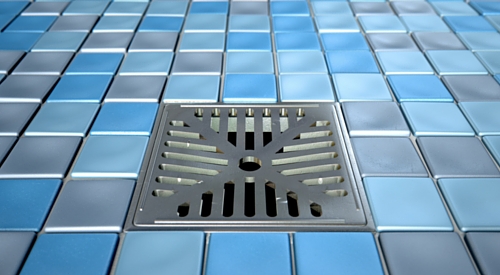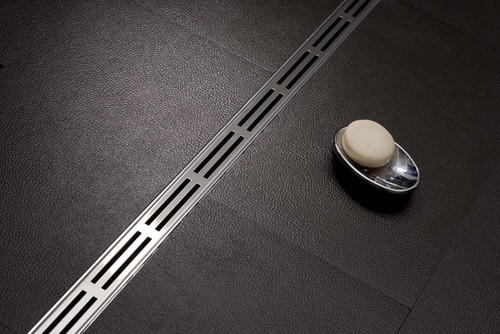Shower drains are so much more than just a grated hole.
In fact, the core of every great shower is the drain. Once regarded as a hole with a grate, shower drains now complete the designer look of modern bathrooms. And you have options:
· Stay with traditional drains that are more versatile than ever.
· Switch to the increasingly popular linear style.
· Simplify with a ready-made pan.
Once you know what you want, make sure it siphons off water efficiently.
As John Whipple, owner of By Any Design, Ltd. says “There is a big difference between ‘staged’ shots and ‘Working Showers’. The difference can be as little as 3/8” or even a 1/4” from a flawless shower to a complete failure.”We’ll look at each style and include some tips on how to make installations go right the first time.
Traditional point drains.
Call it a point, standard, clamping ring, or grate drain – the traditional drain comes in round or square styles that can include custom grills and dress up the shower. In some areas, local code may require a 3-inch drain. It’s always better to have a larger drain than one that just barely keeps up. You can find multiple options for higher-flow-rate drains that handle much more water without sacrificing style.

Traditional Drain
Linear Drains.
Increasing in popularity, linear drains add chic, especially to spa-like and European-style curbless showers. They can be worked into the shower design, or like tile-top drains, almost disappear completely.
Ready-Made fiberglass or Cultured Marble shower bases.
Sometimes budget or time restrictions prevent installing a custom shower pan. This style simplifies the process. It saves dollars in oddly shaped bathrooms where custom pans can be costly. Ready-made bases also hold up better then tile when water quality is an issue and where clients prefer stronger cleaners.
Considerations for new builds and re-model projects.
Linear drains are larger and tend to require more maintenance. When it comes to clogs, look for drains with easy access to hair traps. Some styles have keys to lift the grill.
The number of drains needed depends on amount of water flow. Spa-like showers with multiple heads often require multiple drains.
Point drains can be round or square. Square styles make installation of slopes easier but either way, it’s crucial to make sure weep holes are free of mortar. Take care of this by mounting pea gravel around the drain before the mortar is applied.
Flood testing prevents costly repairs especially for ready-mades and curbless showers.
Bottom line, the best drain for installation is one where the client loves the look, and has the drainage capacity to meet or exceed the highest water flow.
Live easy,
~Jeanette




